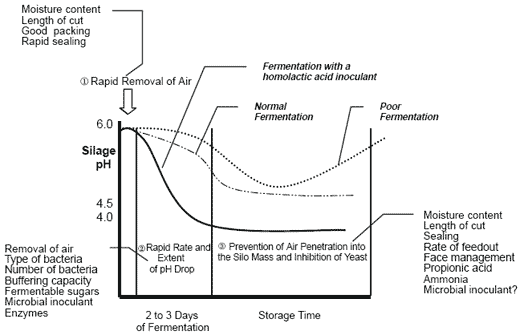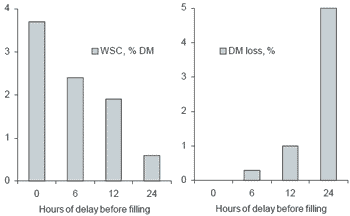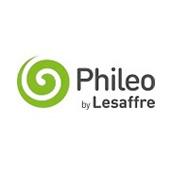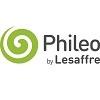Silage Additives
Silage fermentation and additives
The ensiling process
From a practical view, the three most important things that must occur in order to make good silage are 1) the rapid removal of air, 2) the rapid production of lactic acid that results in a rapid drop in pH, and 3) continued exclusion of air from the silage mass during storage and feedout.
After chopping, plant respiration continues for several hours (and perhaps days if silage is poorly packed) and plant enzymes (e.g., proteases) are active until air is used up. Rapid removal of air is important because it prevents the growth of unwanted aerobic bacteria, yeasts, and molds that compete with beneficial bacteria for substrate. If air is not removed quickly, high temperatures and prolonged heating are commonly observed. Air can be eliminated by wilting plant material to the recommended dry matter (DM) content for the specific crop and storage structure, chopping forage to the correct length, quick packing, good compacting, even distribution of forage in the storage structure, and immediately sealing the silo. Air must be removed before optimal fermentation can take place.
Once air is removed, fermentation can begin. Lactic acid bacteria (LAB) utilize water-soluble carbohydrates to produce lactic acid, the primary acid responsible for decreasing the pH in silage. The acidity of silage can be determined by measuring its pH. A pH above 7 is considered basic, 7 is neutral and below pH 7 is acidic. Depending on the crop, the pH of plant material in the field can range from about 5 to 6 and decrease to 3.6 to 4.5 after acid is produced. A quick reduction in silage pH will help to limit the breakdown of protein in the silo by inactivating plant proteases. In addition, a rapid decrease in pH will inhibit the growth of undesirable anaerobic microorganisms such as enterobacteria and clostridia. Eventually, continued production of lactic acid and a decrease in pH inhibits growth of all bacteria. In general, good silage will remain stable, not changing in composition or producing heat once air is eliminated and it has achieved a low pH. This is why filling silos quickly and sealing of silos immediately after filling is so important.
Silage can spoil rapidly if exposed to air during storage and feedout. A common misconception is that molds are responsible for spoilage of silage when it is exposed to air. However, yeasts (not molds) are the primary microorganisms that cause aerobic spoilage and heating. When exposed to air, yeast metabolize lactic acid, causing the pH of the silage to increase, allowing bacteria that were inhibited by low pH to grow and further spoil the mass. Airtight silos and removal of sufficient silage during feedout can help to prevent aerobic spoilage.
Although the ensiling process appears quite simple, many factors can affect what type of fermentation takes place in a silo (Figure 1). For example, the buffering content of the forage mass can have an effect on silage fermentation. Alfalfa has a high buffering capacity in comparison to corn. Thus, it takes more acid production to lower the pH in alfalfa than in corn silage, resulting in the former being more difficult to make. The dry matter content of the forage can also have major effects on the ensiling process via a number of different mechanisms. First, drier silages do not pack well and thus it is difficult to exclude all of the air from the forage mass. Second, as the dry matter content increases, growth of lactic acid bacteria is curtailed and the rate and extent of fermentation is reduced. (For example, acidification occurs at a slower rate and the amount of total acid produced is less).
Thirdly, clostridia tend to thrive in very wet silages and can result in excessive protein degradation, DM loss, and production of toxins. Where weather permits, wilting forage above 30-35% DM prior to ensiling can reduce the incidence of clostridia because these organisms are not very osmotolerant (they do not like dry conditions).
Delayed filling that results in excessive amounts of air trapped in the forage mass can have detrimental effects on the ensiling process. Another factor that can affect the process is the amount of water soluble carbo hydrates (WSC) present for good fermentation to take place. Hirsch and Kung (unpublished data, University of Delaware) showed that WSC dramatically decreased and DM losses increased when corn forage was not immediately packed into silos after chopping (Figure 2). Losses increased as delay was prolonged. The types and numbers of bacteria on the plant also have profound effects on silage fermentation. Natural populations of lactic acid bacteria (LAB) on plant material are often low in number and heterofermentative (produce end products other than lactic acid). In addition, if air is not removed from the silage mass, other types of fermentation can occur. Some important management practices that will help in making high quality silage are listed in Table 1.

Figure 1. The three major events that make good silage and factors that can affect the silage fermentation process.
The end products of silage fermentation are often monitored to assess silage quality; and the composition of ‘normal silages’ is presented in Table 2. High concentrations of ammonia-N, acetic acid, butyric acids, and ethanol are undesirable (Table 3). Some commercial laboratories now offer analytical services for silage end products and such analyses can help to when evaluating silage quality.
Silage inoculants
As shown in Table 3, many end products are commonly produced during the fermentation process but many of these are associated with less than desirable fermentations. Of the several types of acids produced during fermentation, lactic acid is the strongest (10 times stronger than the other acids) and is the preferred end product of silage fermentation. In fact, homolactic acid fermentation producing only lactic acid would be the desired fermentation because of the high energy and DM recoveries (Table 4). Note that in the undesirable fermentations, large amounts of carbon dioxide (CO2) are produced. Because CO2 is a gas, the carbon (or dry matter) is lost to the environment. This explains why these fermentations have low DM recoveries.

Figure 2.Effect of delayed filling on water soluble carbohydrate (WSC) and dry matter loss in corn silage (Hirsch and Kung, University of Delaware, unpublished data).
| Table 1. Some good silage management practices. | ||
| Silage practice | Reasoning | |
| • Harvest crop at correct maturity and DM | • Optimizes nutritive value (protein, fiber, energy, etc.) | |
| • Corn silage: 1/2 to 2/3 milk line; 35% DM | • In some cases optimizes DM content | |
| • Alfalfa: < 1/10 bloom;bunk or bag silo 35 to 45% DM, conventional upright 35 to 50% DM, oxygen limiting silo 45 to 60% DM | • Ensures good packing, elimination of excess oxygen | |
| • Grasses: boot; bunk or bag silo - 35 to 45% DM | • Minimizes seepage losses | |
| Small grains: boot to dough; 30 to 40% DM | • Prevents clostridial (butyric) fermentation | |
| Check that all equipment is in good working order | • Sharpen knives | |
| • Be sure that silos are free from leaks | ||
| • In upright silos, a good distributor helps to distribute and pack silage | ||
| Chop material to correct length: about 3/8 to ½ inch | • Promotes good packing and elimination of oxygen | |
| • Promotes cud chewing by cow | ||
| Wilt and chop during dry weather | • Prevents extensive DM losses from rain | |
| • Promotes rapid drying | ||
| Harvest, fill, and seal quickly | • Quick elimination of oxygen reduces DM losses from respiration and prevents growth of undesirable aerobic organisms | |
| • Sealing minimizes exposure to air (tarps and sheeting) | ||
| • Pack to proper density to eliminate air | ||
| Allow silage to ferment for at least 21 – 28 days | • Properly ensiled forage will minimize production losses during silage changeover | |
| Table 2. Amounts of common fermentation end products in various silages. | |||||
| Item | Alfalfa silage, | Alfalfa silage, | Grass silage, | Corn silage, | High moisture DM corn, |
| 30-35% DM | 45-55% DM | 25-35% | DM 35-40% | 70-73% DM | |
| pH | 4.3 - 4.5 | 4.7 - 5.0 | 4.3 - 4.7 | 3.7 - 4.2 | 4.0 - 4.5 |
| Lactic acid, % | 7 - 8 | 2 - 4 | 6 - 10 | 4 - 7 | 0.5 - 2.0 |
| Acetic acid, % | 2 - 3 | 0.5 - 2.0 | 1 - 3 | 1 - 3 | < 0.5 |
| Propionic acid, % | < 0.5 | < 0.1 | < 0.1 | < 0.1 | < 0.1 |
| Butyric acid, % | < 0.5 | 0 | <0.5 | 0 | 0 |
| Ethanol, % | 0.5 - 1.0 | 0.5 | 0.5 - 1.0 | 1 - 3 | 0.2 - 2.0 |
| Ammonia-N, % of crude protein | 10 – 15 | < 12 | 8 - 12 | 8 - 12 | < 10 |
| Table 3. Common end products of silage fermentation. | ||
| Item | Positive or negative effect | Action(s) |
| pH | + | Low pH inhibits bacterial activity. |
| Lactic acid | + | Inhibits bacterial activity by lowering pH. |
| Acetic acid | - | Associated with undesirable fermentations. |
| + | Inhibits yeasts responsible for aerobic spoilage. | |
| Butyric acid | - | Associated with protein degradation, toxin formation, and large losses of DM and energy. |
| Ethanol | - | Indicator of undesirable yeast fermentation and high DM losses. |
| Ammonia | - | High levels indicate excessive protein breakdown |
| Acid detergent insoluble nitrogen | - | High levels indicate heat-damaged protein and low energy content. |
| Table 4. Predominant fermentation pathways in silage. | |||
| Type of fermentation | End products | Theoretical DM recovery (%) | Theoretical energy recovery (%) |
| Homolactic (glucose) | lactic acid | 100 | 99 |
| Heterolactic (glucose) | lactic acid, ethanol, CO2 | 76 | 98 |
| Heterolactic (fructose) | lactic acid, acetate, mannitol, CO2 | 95 | 99 |
| Yeast (glucose) | ethanol, CO2 | 51 | 99 |
| Clostridia (glucose and lactate) | butyric acid, CO2 | 49 | 82 |
ORGANISMS
Because forage often naturally contains many detrimental types of bacteria, the purpose of adding a microbial inoculant to silage is to add fast growing homofermentative lactic acid bacteria in order to dominate the fermentation, resulting in a higher quality silage. Some of the more common homolactic acid bacteria used in silage inoculants include Lactobacillus plantarum, L. acidophilus, Pediococcus acidilactici, P. pentacaceus and Enterococcus faecium. Microbial inoculants contain one or more of these bacteria which have been selected for their ability to dominate the fermentation. The rationale for multiple organisms comes from potential synergistic actions. For example, growth rate is faster in Enterococcus > Pediococcus > Lactobacillus. Some Pediococcus strains are more tolerant of high DM conditions than are Lactobacillus and have a wider range of optimal temperature and pH for growth (they grow better in cool conditions found in late fall and early spring). Table 5 lists several common and one experimental microbe that have been studied as silage inoculants.
| Table 5. Some of the more common bacteria used as silage inoculants and some reasons for their use. | |||
| Organism | Type of organism | General reasons for addition | Primary end products |
| Lactobacillus plantarum | Lactic acid bacteria, homolactic | rapid production of lactic acid relatively acid tolerant | Lactic acid |
| Pediococcus acidilactici, cerevisiae | Lactic acid bacteria, homolacti | rapid production of lactic acid faster growing than Lactobacillus some strains show good growth at cooler temperatures some strains have good osmotolerance | Lactic acid |
| Enterococcus faecium | Lactic acid bacteria, homolactic | rapid production of lactic acid faster growing than Lactobacillus | Lactic acid |
| Propionibacterium shermanii, jensenii | Propionibacteria | production of antifungal compounds | Propionic and acetic acids, CO2 |
FERMENTATION AND ANIMAL RESPONSES
Alfalfa, grass, and small cereal grain crops have responded well to microbial inoculation with homofermentative LAB. The fermentation of high moisture corn has also been improved with homofermentative LAB. However, microbial inoculation of corn silage has resulted in less consistent results.
For example, I found 14 published (peer reviewed) studies in North America where corn silage was treated with a homofermentative LAB microbial inoculant. Improvements in animal performance were found in only three instances and changes in fermentation end products were small. However, Bolsen et al. (1992) reported that in 19 studies on beef cattle conducted at Kansas State University corn silages inoculated with homofermentative LAB gave 1.3 percentage units higher in DM recovery, 1.8% improvement in efficiency and 3.6 lb more gain in beef cattle per ton of crop ensiled. Similar results were found with treated sorghum silages. In certain instances, significant animal responses have been observed with inoculation although there was little effect on traditional end products of fermentation (Gordon, 1989; Kung et al., 1993). These data suggest that lack of detectable changes in classically measured fermentation end products is not a good indicator of the effectiveness of an inoculant.
When compared to untreated silages, silages treated with adequate numbers of a viable homofermentative LAB should be lower in pH, acetic acid, butyric acid and ammonia-N, but higher in lactic acid content (Table 6). In a review of the literature between 1990-95, Muck and Kung (1997) reported that microbial inoculation lowered pH, improved the lactic:acetic ratio, and lowered ammonia-N content in more than 60% of studies. Dry matter recovery was improved in 35% of the studies. Dry matter digestibility was also improved in about one third of the cases. Microbial inoculation usually has little or no effect on the fiber content of silages because most lactic acid bacteria have little or no ability to degrade plant cell walls. Decreases in fiber content may be due to partial acid hydrolysis of hemicellulose. Some data suggest that certain microbial inoculants can increase fiber digestion (Rice et al., 1990). Bunk life or aerobic stability was improved in only 33% of the studies and in fact inoculation with homofermentative LAB has, in many instances, made aerobic stability worse. This is probably due to a lower content of acetic acid and other potential antifungal end products.
This finding is extremely ironic because many producers buy microbial inoculants because they perceive an improvement in aerobic stability. Silage treated with homofermentative LAB can be extremely stable if feeding and silo management is good.
Kung and Muck (1997) reported positive responses to microbial inoculants on intake, gain, and milk production (Table 7). The average increase in milk production was 3.1 lb per day in studies where milk production was statistically improved. Although literature summaries are encouraging, caution should be used when interpreting such data because all inoculants are not equal and the conditions (e.g. rate of application, inoculant viability, species of bacteria, crop, moisture levels) varied markedly among the studies. As many have pointed out in the past, products with organisms with the same name are not necessarily the same organism and may not have the same effectiveness (Dennis, 1992). For example, Rooke and Kafilzadeh (1994) reported that various strains of homofermentative LAB improved silage fermentation but animal performance was improved by only one strain.
| Table 6. Theoretical effect of adding a microbial inoculant containing homofermentative lactic acid bacteria on the end products of silage fermentation. | |
| Item | Theoretical effect |
| DM recovery | Greater recovery |
| Rate of pH decline and final pH | Faster decline and lower final pH |
| Ammonia nitrogen | Lower content |
| Lactic acid | Greater content |
| Acetic acid | Lower content |
| Butyric acid | Lower content |
| Ethanol | Lower content |
| Fiber (NDF/ADF) | No change |
| Digestibility | Increased |
| Animal performance | Increased |
| Table 7. A summary of animal responses to microbial inoculants between 1990 and 1995. | |||
| Type of study | Intake | Gain | Milk production |
| Number of studies | 6 7 | 1 5 | 3 6 |
| Studies with positive responses | 28% | 53% | 47% |
| Kung and Muck (1997) |
Unfortunately, there is no good way to predict the effectiveness of microbial inoculants. A model developed by Pitt (1990) suggested that inoculants would be most effective on alfalfa during cool conditions of first, third and fourth cuttings. However, there are numerous products with little or no research to support claims of improved fermentation or animal performance. Another factor which complicates the evaluating process is that the majority of bacterial inoculants are repackaged for distribution under private label and numbers of bacteria may be low and/or other additives (e.g., enzymes, fermentation extracts, minerals) are included in the formulations.
INOCULATION RATE, USE AND STORAGE
The organism(s) from microbial inoculants must be present in sufficient numbers to effectively dominate the fermentation. The most commonly recommended inoculation rate for L. plantarum-based inoculants result in a final concentration of 100,000 (or 1 × 105) colony forming units per gram of wet forage. There is limited evidence to support the suggestion of some that doubling or tripling this amount (e.g. 200,000-300,000 CFU) is more beneficial in North American silages; however higher inoculation rates are typically used on the low dry matter grass silages produced in many parts of Europe.
Most microbial inoculants are available in powder or granular form. Inoculants applied in the dry form are often mixed with calcium carbonate (limestone), dried skim milk, sucrose or other carriers.
These products can be applied by hand or by solid metering devices as per manufacturer’s recommendations. Inoculants to be applied in the liquid form come as dried powders and are mixed with water just prior to use. (Use of chlorinated water may be detrimental to the inoculant if chlorine levels exceed more than 1.5 to 2 ppm.) Application can be with a simple watering can by weighing the incoming forage load and adjusting application based on the average unloading time.
A better method is to use a metered liquid sprayer to evenly disperse the inoculant on the forage. Unused liquids should be discarded after a period of 24-48 hrs because bacterial numbers begin to decline. Microbial inoculants can be applied to the forage at a variety of locations (Table 8). However, application to forage at the chopper is highly recommended in order to maximize the time that microorganisms are in contact with fermentable substrates. Application at the chopper is more important if silage is being stored in a bunk or pile because it is difficult to achieve good distribution onto silage from a forage wagon. Distribution of the inoculant is less of a problem if it is applied at the blower of an upright silo or at the bagger. Throwing a can of dry inoculant onto a load of forage and hoping for even distribution is not an acceptable practice! Inoculants can be applied in a liquid or solid form. Data from our lab (Whiter et al., 1999) suggest that on higher DM silages (greater than about 45% DM), using a liquid based inoculant is preferable because the low moisture in these silages limits fermentation (Table 9). Inoculants applied in a liquid form may be more advantageous because the bacteria are added with their own moisture to help speed up fermentation.
| Table 8. Preferred site of application for a microbial inoculant. | |||
| Site of application | |||
| Type of silo | First choice | Second choice | |
| Bunk, pile, pit | Chopper | Silo | |
| Upright bag | ------------------------------ | Chopper or Silo* | ------------------------------ |
| *First choice at chopper if time between chopping and filling is more than 2 to 3 hours. |
| Table 9. Preferred mode of application for a microbial inoculant. | |||
| Mode of application | |||
| DM content of forage | First choice | Second choice | |
| < 35 to 40% | ------------------------------ | Dry or Liquid | ------------------------------ |
| > 40 to 45% | Liquid | Dry | |
| *First choice at chopper if time between chopping and filling is more than 2 to 3 hours. |
Storage is an important aspect of a high quality inoculant that contains live microorganisms. Some inoculants require refrigeration or freezing for optimum storage. Those that do not require cold temperatures for storage should still be kept in cool, dry areas away from direct sunlight. Moisture, oxygen and sunlight can decrease the stability of inoculants resulting in lower viable counts and a product that does not meet label guarantees. Opened bags of inoculants should be used as soon as possible and, if not completely used, probably not carried over into the next season.
MISCELLANEOUS ORGANISMS
Several microorganisms that are not homofermentative LAB have been used as silage inoculants specifically for the purpose of improving aerobic stability. For example, the Propionibacteria are able to convert lactic acid and glucose to acetic and propionic acids that are more antifungal than lactic acid. Florez-Galaraza et al. (1985) reported that addition of P. shermanii prevented the growth of molds and markedly reduced the initial population of yeast in high moisture corn where the final pH was greater than 4.5. Dawson (1994) reported similar findings in high moisture corn. Weinberg et al. (1995) saw little benefit from adding Propionibacteria to pearl millet and corn silage (final pH < 4.0) but reported improvements in the aerobic stability of wheat silage when the decline in pH was slow.
Similarly, in three studies using laboratory silos, we (Kung et al., unpublished data) did not observed beneficial effects of Propionibacteria in corn silage (final pH 3.6 to 3.8). However, Bolsen et al. (1996) reported more propionic acid, fewer yeasts and molds and greater aerobic stability in corn silage (pH of 3.6) treated with Propionibacteria. Some concerns relative to the use of Propionibacteria that have not been adequately addressed are the loss of DM (from CO2 production) and the fact that Propionibacteria have proteolytic activity. The primary reasons for the ineffectiveness of these organisms include the facts that they are strict anaerobes, they are slow growing, and they are relatively acid intolerant.
Heterolactic lactobacilli may also be useful as silage inoculants. For example, two new isolated heterolactic strains of L. plantarum have been shown to improve the aerobic stability of corn silage by an average of 28 hrs in five studies (Allman and Stern, 1999). These organisms were selected for fast growth, production of lactic and acetic acids, and the ability to suppress the growth of five major strains of yeasts that cause spoilage in corn silage.
Another heterolactic acid bacterium having potential to improve the aerobic stability of silages is Lactobacillus buchneri. Driehuis et al. (1996) reported that corn silage treated with L. buchneri was more stable than untreated silage. They suggest that improved aerobic stability was due to the ability of L. buchneri to ferment lactic acid to acetic acid and 1,2 propanediol (Oude-Elferink et al., 1999). Our laboratory (Ranjit et al., 1998) added L. buchneri to corn silage at a rate of 1 × 106 CFU/g of silage and found decreased numbers of yeasts and increased acetic acid in silage (from 1.8 to 3.6%, DMB). Aerobic stability was markedly improved by inoculation (control silage heated after 26 hrs while treated silages remained cool for more than 400 hrs in silage). Increases in acetic and propionic acids in silages treated with L. buchneri accompanied improvements in the aerobic stability of barley silage (Kung et al., 1999). We also have observed improved aerobic stability in high moisture corn treated with L. buchneri (Taylor and Kung, unpublished data, University of Delaware).
These data are exciting but some have criticized the use of heterolactic organisms because their metabolism could lead to excessive DM loss in the silo. In addition, high levels of acetic acid may depress animal intakes. To date, in research studies, losses of DM have been small and no negative effects on animal performance have been observed when feeding silages treated with L. buchneri.
Enzymes as silage additives
Enzymes were originally added to silage to partially degrade fiber to fermentable water soluble carbohydrates for use by lactic acid bacteria, which cannot use fiber as an energy source to make lactic acid. Thus, they were not designed to result in excessive degradation of fiber in the silo.
Cellulase (degrades cellulose) and hemicellulase (degrades hemicellulose) enzyme complexes are commonly mixed with microbial inoculants to form silage additives. Very few, if any, silage additives comprised only of enzymes exist on the North American market. Thus, it has been difficult to assess the effect of enzymes on silage fermentation and animal performance. In general, there have been fewer studies on silages treated with enzymes than on those treated with microbial inoculants. Effects on subsequent animal performance have also been less than found with inoculants. In a review of literature published between 1990-1995, Kung and Muck (1997) reported that the proportion of enzyme treatment studies showing positive effects on animal performance was 21% for intake (n = 29), 40% for gain (n = 10), 33% for milk production (n = 12) and 27% for feed efficiency (n = 11). The average increase in milk production was 2 lb per day in studies where milk production was enhanced. Improvements in DM digestion were only positive 9% of the time (n = 78), which leaves much speculation as to how enzyme treatment results in improved animal performance.
Buffered propionic acid-based additives
Of the short-chain fatty acids, propionic acid has the greatest antimycotic activity. It is effective in reducing yeast and molds which are responsible for aerobic deterioration in silages. The antimycotic effect of propionic acid is enhanced as pH declines, making it an ideal candidate for improving the aerobic stability of corn silage where pH is low. In the past, aerobic stability was improved when large amounts of propionic acid (1 to 2% of the DM) were added to silage, but the high percentage of acid restricted fermentation in these cases. Propionic acid is also difficult to handle because it is corrosive.
Thus, the acid salts, e.g., calcium, sodium and ammonium propionate, have become more widely used in commercial products. The efficacy of propionic acid and its salts is closely related to their solubility in water. The stronger the bond is between the acid and base, the less soluble the product is and thereby less effective in inhibiting fungi. Among these salts, ammonium propionate is most soluble in water (90%), followed by sodium propionate (25%) and calcium propionate (5%). Most current additives containing buffered propionic acid and other antifungal components (e.g., citric acid, benzoic acid, and sorbic acid) have low suggested rates of application (2-4 lb per ton of fresh forage weight). These low application rates usually do not affect silage fermentation, but reduce the numbers of yeasts that cause aerobic spoilage and improve aerobic stability (Table 10). Several additives containing buffered propionic acid are available that were designed for use in the total mixed ration just prior to feeding to prevent heating and spoiling in the feed bunk. However, research from our lab suggests that controlling yeasts at the time of ensiling is more efficient than trying to control their numbers and metabolism in the feed bunk.
| Table 10. Effect of a propionic acid-based additive on the number of yeasts and hours of aerobic stability of corn silage. | ||
| Treatment*, application rate | Yeast in silage (Number/g) | Aerobic stability (hrs)** |
| Untreated | 257,000 | 65 |
| Product A, 2 lb/ton of wet silage | 27,000 | 120 |
| Product A, 4 lb/ton of wet silage | 2,800 | >160 |
| *Product A contained buffered propionic acid (primary active ingredient) and other active ingredients. **Hours before the temperature of the silage rose more than 20C. Kung et al., 1998. |
| Conclusions |
| Silage additives can be useful tools to improve silage quality and animal performance; however, they are not replacements for good management practices. The question of which additive to use can sometimes be a difficult one. Table 11 shows some suggestions for use of silage additives. Cost of the product should not be the most important factor when choosing an additive! Proof of efficacy and cost should be considered together. Why buy a cheap additive that is ineffective? In contrast, the most expensive additive might not be the best, either. How should one evaluate a silage additive? In my opinion, in choosing an additive in North America one should require an extensive database proving efficiency in a broad range of conditions (crop, moisture content, etc) in three areas: 1) improvements in animal production; 2) imrovements in DM or nutrient recovery; 3) improved aerobic stability. Finally, choose an additive from a reputable company that stands behind their products and offers excellent technical service support. |
| Table 11. Some suggestions for use of silage additives. | |
| Major observation | Additive of choice |
| 1. Consistently make good quality silage. | 1. Homolactic acid based inoculant. |
| 2. No significant heating problems. | |
| 1. Consistently make good quality silage. | 1. Homolactic acid based inoculant and |
| 2. Some heating problems during warm weather. | 2. Buffered propionic acid preservative added to TMR at feeding. |
| 1. Usually make good quality silage. | 1. Homolactic acid based inoculant and |
| 2. Spoiled or hot silage usually only at silo opening and when feeding out the last silage from silo. | 2. Buffered propionic acid preservative or inoculants designed to improve aerobic stability on several first and last loads into silo. |
| 1. Consistently have problems with heating silage. | 1. Buffered propionic acid preservative at ensiling or |
| 2. Inadequate daily removal of silage leading to hot feed. | 2. Microbial inoculants designed to improve aerobic stability. |
| 1. For bunk, pit, or drive-over silos, significant spoilage on top layer even after covering. | 1. Buffered propionic acid preservative or |
| 2. Microbial inoculants designed to improve aerobic stability only on last loads into silo. | |
| 1. Extremely dry forage or forage chopped too long | 1. Buffered propionic acid preservative or |
| 2. Microbial inoculants designed to improve aerobic stability. |
References
Allman, J.G. and L.A. Stern. 1999. Biomax®5 microbial inoculant for corn silage. http://www.chbiosystems.com/new_products/biomax/biomax.html
Bolsen, K.K. 1995. Silage additives. In: Biotechnology in Animal Feeds and Animal Feeding (R.J. Wallace and A Chesson, eds.). VCH, New York. pp. 33-54.
Bolsen, K.K., R.N. Sonon, B. Dalke, R. Pope, J.G. Riley and A. Laytimi. 1992. Evaluation of inoculant and NPN silage additives. A summary of 26 trials and 65 farm-scale silages. Rept. of Prog. Kansas State Univ.
Bolsen, K.K., D.R. Bonilla, G.L. Huck, M.A. Young, R.A. Hart-Thakur and A Joyeaux. 1996. Effect of a propionic acid bacterial inoculant on fermentation and aerobic stability of whole-plant corn silage. J. Anim. Sci. 74(Suppl. 1):274.
Dawson, T.E. 1994. Propionic acid-producing bacteria as bioinoculants for the preservation of ensiled high-moisture corn. Ph.D. Diss. Michigan State Univ., East Lansing.
Dennis, S.M. 1992. Influence of strain composition of silage inoculants on silage quality. Proc. Calif. Anim. Nutr. Conf. Tech. Symp. Fresno, CA.
Dreihuis, F., S.F. Spoelstra, S.C.J. Cole and R. Morgan. 1996. Improving aerobic stability by inoculation with Lactobacillus buchneri. Proc. of the XI Intl. Silage Conf., IGER, Aberystwyth. pp. 106-107.
Flores-Galaraza, R.O., B.A. Glatz, C.J. Bern and L.D. Van Fossen. 1985. Preservation of high-moisture corn by microbial fermentation. J. Food Protection. 48:407-411.
Gordon, F.J. 1989. A further study on the evaluation through lactating cattle of a bacterial inoculant as an additive for grass silage. Grass and Forage Sci. 44:353.
Kung, Jr., L. and R.E. Muck. 1997. Animal response to silage additives. Proc. from the Silage: Field to Feedbunk. North American Conference. NRAES - 99. Pages 200-210.
Kung, L., Jr., J.H. Chen, E. M. Kreck and K. Knutsen. 1993. Effect of microbial inoculants on the nutritive value of corn silage for lactating dairy cows. J. Dairy Sci. 76:3763.
Kung Jr., L., A.C. Sheperd, A.M. Smagala, K.M. Endres, C.A. Bessett, N.K. Ranjit and J.L. Glancey. 1998. The effect of propionic acid-based preservatives on the fermentation and aerobic stability of corn silage and a total mixed ration. J. Dairy Sci. 81:1322-1330.
Kung Jr., L., N.K. Ranjit, J.R. Robinson and R.C. Charley. 1999. The effect of Lactobacillus buchneri on the fermentation and aerobic stability of barley silage. The XIIth International Silage Conference. Uppsala, Sweden. pp. 272-273.
Muck, R.E. and L. Kung, Jr. 1997. Effects of silage additives on ensiling. Proc. from the Silage: Field to Feedbunk. North American Conference. NRAES – 99. pp. 187-199.
Oude Elferink, S.J.W.H., F. Diehuis, J. Krooneman, J. Gottschal and S.F. Spoelstra. 1999. Lactobacillus buchneri can improve the aerobic stability of silage via a novel fermentation pathway: the anaerobic degradation of lactic acid to acetic acid and 1,2 propanediol. Proc. XII Intl. Silage Conf., Uppsala, Sweden. Swedish Univ. Agric. Sci., pp. 266-267.
Pitt, R.E. 1990. The probability of inoculant effectiveness in alfalfa silages. Transactions of the ASAE. 33:1771.
Ranjit, N.K., M. A. Cohen, R. C. Smoot, J. Y. Tavares, and L. Kung, Jr. 1998. The effects of Lactobacillus plantarum (LP), L. buchneri (LB) and a propionic acid-based preservative on the fermentation and aerobic stability of corn silage and the aerobic stability of a TMR. J. Dairy Sci. 81(Suppl. 1):196.
Rice, D.W., S.D. Soderlund, I.E. Phillip and J.H. Harrison. 1990. Effect of microbial inoculation on digestibility of legume silages. J. Dairy Sci. 73(Suppl. 1):195.
Rooke, J.A. and F. Kafilzadeh. 1994. The effect upon fermentation and nutritive value of silages produced after treatment by three different inoculants of lactic acid bacteria applied alone or in combination. Grass and Forage Sci. 49:42-53.
Weinberg, Z.G., G. Ashbell, K.K. Bolsen, G. Pahlow, Y. Hen and A. Azrieli. 1995. The effect of a propionic acid bacterial inoculant applied at ensiling, with or without lactic acid bacteria, on the aerobic stability of pearl-millet and maize silages. J. Appl. Bacteriol. 78:430-436.
Whiter, A.G., L. Kung, Jr., N.K. Ranjit, J.Y. Tavares and J.R. Robinson. 1999. The interactions between silage dry matters and forms of bacterial inoculants. J. Dairy Sci. 82(Suppl. 1):125.
Author: LIMIN KUNG, JR.
Department of Animal and Food Sciences, University of Delaware, Newark, Delaware, USA








